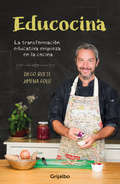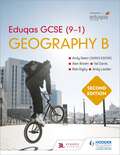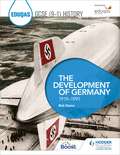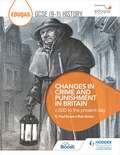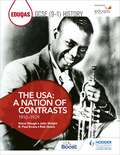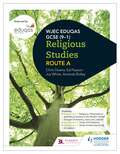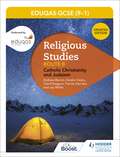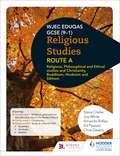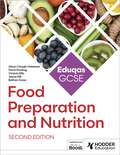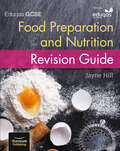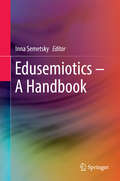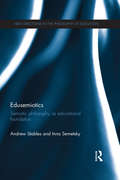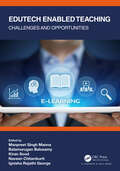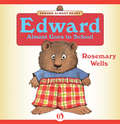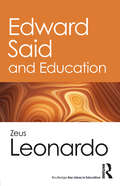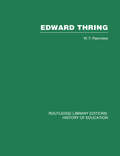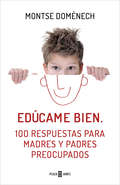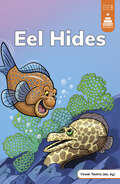- Table View
- List View
Educocina: La transformación educativa empieza en la cocina
by Diego Ruete Jimena FolleTexto invaluable a la hora de emprender el camino hacia una alimentación saludable como forma de vida. Los adultos transmitimos mucho más de lo que decimos, por esto necesitamos asumir el rol que cumplimos en la educación alimentaria en la infancia. Necesitamos adultos que se detengan, que lean las etiquetas, que sean críticos a la hora de comprar alimentos, que se interesen más por el contenido que por el envoltorio, que se animen a cocinar más. Para lograr esto necesitamos reaprender a organizar nuestras jornadas, a rearmar nuestras prioridades y, sobre todo, las de nuestros niños. En este libro, Diego Ruete apela a su enorme experiencia como educador para compartir con nosotros estrategias que nos ayudarán en el camino hacia la alimentación como forma de compartir el amor. El libro se enriquece con la solidez conceptual de Jimena Folle y los aportes de reconocidos especialistas en diversas áreas que, junto con la exitosa praxis de Diego Ruete y de Inés Marracos, conforman un texto invaluable a la hora de emprender el camino hacia una alimentación saludable como forma de vida. En una sociedad donde aparecen como consumibles cada vez más cosas que en realidad no son alimentos, la educación alimentaria juega un rol esencial. La comida debe retornar a hacer su verdadero trabajo, debe nutrir para el desarrollo, debe aportar para la salud, no enfermar. En estas páginas encontraremos conceptos, consejos y herramientas que contribuirán a reconectarnos con los alimentos de una manera saludable.
Edupreneur
by Dave Faulkner Aaron TaitIf you can change education, you can change the world Edupreneur gives teachers the "how." You already know what needs to be done to improve education, but you may lack the support and processes to bring it to life--and that's where this book comes in. You'll walk through the four stages of innovation--dreaming, digging, making and sharing--and learn how to unleash ground-shaking change from the classroom up. Straightforward, highly practical and kick-in-the-pants inspirational, this book is your new companion for making education work. You'll read about passionate teachers who have raised attendance from 40% to 90%; you'll read about principals who took on the worst-performing schools and turned them around; you'll read about leaders who had the courage to take the reins of a school and turn it from good to great--and you'll learn how they did it and how you're entirely capable of the same kind of revolutionary change. This is a book not just for challenging schools, but for all educators who are passionate about providing a great education for every student, every day. Administrators, academics and politicians can debate endlessly about how to "fix our schools," ignoring the fact that their best innovators and catalysts of change are already right there in the classroom. You have plenty of ideas, so here's your license to make them happen. Edupreneur will help teachers in all schools to: Identify ways to improve day-to-day practice Overcome the challenges that hamper progress Create new solutions that sidestep old roadblocks Collaborate with similarly forward-thinking educators Imagine what education could look like if teachers were practically equipped to bring exciting new ideas to the classroom every day. Edupreneur helps you be that kind of teacher you've always wanted to be, with a clear framework for truly bringing on the change.
Eduqas GCSE (9-1) Geography B Second Edition
by Alan Brown Bob Digby Andy Leeder Andy Owen Val DavisDevelop your students' subject knowledge and skills using this second edition Eduqas GCSE (9-1) Geography B Student book.Featuring updated case studies, practice questions and clear presentation of key terms, this thoroughly revised edition provides students with the up-to-date knowledge they need to succeed at GCSE.- Enhances students' subject knowledge, critical thinking and problem-solving skills using clear explanations of geographical issues, brought to life through an exciting, enquiry-based approach- Teaches students how to interpret, analyse and evaluate geographical information through a range of progressive, skills-building activities that use real-place data, maps and photographs- Boosts candidates' confidence approaching examination by providing opportunities for practice for each assessed theme- Highlights possible fieldwork projects and contains guidance on carrying out investigations that meet the changed assessment requirements
Eduqas GCSE (9-1) Geography B Second Edition
by Alan Brown Bob Digby Andy Leeder Andy Owen Val DavisDevelop your students' subject knowledge and skills using this second edition Eduqas GCSE (9-1) Geography B Student book.Featuring updated case studies, practice questions and clear presentation of key terms, this thoroughly revised edition provides students with the up-to-date knowledge they need to succeed at GCSE.- Enhances students' subject knowledge, critical thinking and problem-solving skills using clear explanations of geographical issues, brought to life through an exciting, enquiry-based approach- Teaches students how to interpret, analyse and evaluate geographical information through a range of progressive, skills-building activities that use real-place data, maps and photographs- Boosts candidates' confidence approaching examination by providing opportunities for practice for each assessed theme- Highlights possible fieldwork projects and contains guidance on carrying out investigations that meet the changed assessment requirements
Eduqas GCSE (9-1) History (9-1) History (9-1) History (9-1) History (9-1) History (9-1) History (9-1) History (9-1) History (9-1) History (9-1) History (9-1) History (9-1) History (9-1) History (9-1) History (9-1) History (9-1) History: The Development of Germany, 1919-1991: The Development Of Germany 1919-1991
by Rob QuinnExam board: EduqasLevel: GCSESubject: HistoryFirst teaching: September 2016First exams: June 2018Endorsed by EduqasHelp every student to achieve their best, with bespoke support for Eduqas GCSE History from the leading History publisher for secondary schools.Structured around the key questions in the 2016 specification, this book:> Develops in-depth subject knowledge through clear and detailed coverage of the important issues, events and concepts> Builds students' historical skills and thinking as they progress through a range of activities and questions> Prepares students for assessment by providing step-by-step guidance and model answers for each question type> Increases understanding and enjoyment by including a rich variety of source material that brings the period to life
Eduqas GCSE (9-1) History (9-1) History (9-1) History (9-1) History (9-1) History (9-1) History (9-1) History (9-1) History: The Development of Germany, 1919-1991: The Development Of Germany 1919-1991
by Rob QuinnExam board: EduqasLevel: GCSESubject: HistoryFirst teaching: September 2016First exams: June 2018Endorsed by EduqasHelp every student to achieve their best, with bespoke support for Eduqas GCSE History from the leading History publisher for secondary schools.Structured around the key questions in the 2016 specification, this book:> Develops in-depth subject knowledge through clear and detailed coverage of the important issues, events and concepts> Builds students' historical skills and thinking as they progress through a range of activities and questions> Prepares students for assessment by providing step-by-step guidance and model answers for each question type> Increases understanding and enjoyment by including a rich variety of source material that brings the period to life
Eduqas GCSE (9-1) History Changes in Crime and Punishment in Britain c.500 to the present day
by R. Paul Evans Rob QuinnExam board: EduqasLevel: GCSESubject: HistoryFirst teaching: September 2016First exams: June 2018Endorsed by EduqasHelp every student to achieve their best, with bespoke support for Eduqas GCSE History from the leading History publisher for secondary schools.Structured around the key questions in the 2016 specification, this book:> Develops in-depth subject knowledge through clear and detailed coverage of the important themes, perspectives and developments> Builds students' historical skills and thinking as they progress through a range of activities and questions> Prepares students for assessment by providing step-by-step guidance and model answers for each question type> Increases understanding and enjoyment by including a rich variety of source material that brings different periods to life
Eduqas GCSE (9-1) History Changes in Crime and Punishment in Britain c.500 to the present day
by R. Paul Evans Rob QuinnExam board: EduqasLevel: GCSESubject: HistoryFirst teaching: September 2016First exams: June 2018Endorsed by EduqasHelp every student to achieve their best, with bespoke support for Eduqas GCSE History from the leading History publisher for secondary schools.Structured around the key questions in the 2016 specification, this book:> Develops in-depth subject knowledge through clear and detailed coverage of the important themes, perspectives and developments> Builds students' historical skills and thinking as they progress through a range of activities and questions> Prepares students for assessment by providing step-by-step guidance and model answers for each question type> Increases understanding and enjoyment by including a rich variety of source material that brings different periods to life
Eduqas GCSE (9-1) History The USA (9-1) History The USA (9-1) History The USA (9-1) History The USA (9-1) History The USA (9-1) History The USA (9-1) History The USA (9-1) History The USA: A Nation of Contrasts 1910-1929: A Nation Of Contrasts 1910-1929
by John Wright Steve Waugh R. Paul Evans Rob QuinnExam board: EduqasLevel: GCSESubject: HistoryFirst teaching: September 2016First exams: June 2018Endorsed by EduqasHelp every student to achieve their best, with bespoke support for Eduqas GCSE History from the leading History publisher for secondary schools.Structured around the key questions in the 2016 specification, this book:> Develops in-depth subject knowledge through clear and detailed coverage of the important issues, events and concepts> Builds students' historical skills and thinking as they progress through a range of activities and questions> Prepares students for assessment by providing step-by-step guidance and model answers for each question type> Increases understanding and enjoyment by including a rich variety of source material that brings the period to life
Eduqas GCSE (9-1) History The USA (9-1) History The USA: A Nation of Contrasts 1910-1929: A Nation Of Contrasts 1910-1929
by John Wright Steve Waugh R. Paul Evans Rob QuinnExam board: EduqasLevel: GCSESubject: HistoryFirst teaching: September 2016First exams: June 2018Endorsed by EduqasHelp every student to achieve their best, with bespoke support for Eduqas GCSE History from the leading History publisher for secondary schools.Structured around the key questions in the 2016 specification, this book:> Develops in-depth subject knowledge through clear and detailed coverage of the important issues, events and concepts> Builds students' historical skills and thinking as they progress through a range of activities and questions> Prepares students for assessment by providing step-by-step guidance and model answers for each question type> Increases understanding and enjoyment by including a rich variety of source material that brings the period to life
Eduqas GCSE (9-1) Religious Studies Route A
by Joy White Chris Owens Ed Pawson Amanda RidleyExam Board: WJECLevel: GCSESubject: Religious StudiesFirst Teaching: September 2016First Exam: June 2018Bring out the best in every student, enabling them to develop in-depth subject knowledge with this accessible and engaging Student's Book, created for the 2016 specification by a team of subject specialists.- Helps students of all abilities fulfill their potential and increase their understanding through clear, detailed explanations of the key content and concepts- Motivates students to build and cement their knowledge and skills using a range of imaginative, innovative activities that support learning and revision- Provides a variety of quotes from sources of authority that students can draw on to enhance their responses and extend their learning- Encourages students to make links between the world religions and philosophical and ethical issues so they develop a holistic view of religion in modern Britain- Prepares students for examination with a rich bank of exam-style questions, guidance on how to improve responses and student-friendly assessment criteria- Enables you to teach unfamiliar topics and systematic studies confidently with clear explanations of Christian, Catholic Christian, Islamic and Judaic beliefs and practices, verified by faith organisationsWJEC Eduqas GCSE RSComponent 1: Religious, philosophical and ethical studies in the Modern World1 Issues of Relationship2 Issues of Life and Death3 Issues of Good and Evil4 Issues of Human RightsComponent 2: 5 Beliefs and teachings6 Christianity: PracticesComponent 3: Study of a World Faith - Islam7 Islam: Beliefs and teachings8 Islam: PracticesComponent 3: Study of a World Faith - Judaism9 Judaism: Beliefs and teachings10 Judaism: Practices
Eduqas GCSE (9-1) Religious Studies Route B (9-1) Religious Studies Route B (9-1) Religious Studies Route B (9-1) Religious Studies Route B: Catholic Christianity and Judaism: Catholicism And Judaism
by Andrew Barron Joy White Deirdre Cleary Patrick HarrisonHelp students to build their subject knowledge and understanding with this accessible and engaging Student's Book, created for the 2016 WJEC Eduqas GCSE (9-1) Religious Studies Route B specification by subject specialists with examining experience. - Feel confident teaching the Catholic and Judaism content with expert guidance written by faith experts and Diocesan advisors.- Develop understanding through clear, accessible explanations of the specification content and key concepts. - Keep track of progress with learning objectives and summaries for every topic.- Engage students and cement knowledge and skills using a range of assessment related tasks, activities and guidance that support learning and revision.- Cater for students of varying learning styles through a visually engaging approach that uses photos and artwork to enhance subject interest and understanding.To access draft content please log into www.wjecservices.co.uk. Your centre's unique login and username will be available from your Exams Officer. You will need permissions access to the 'Subject specific material including CPD' section.
Eduqas GCSE (WJEC Religious Education)
by Steve Clarke Joy White Chris Owens Ed Pawson Amanda RidleyBring out the best in every student; enable them to develop in-depth subject knowledge with this accessible and engaging Student Book, created by subject specialists and covering the content your students need to know for the reformed specification in a single book.- Helps students of all abilities fulfil their potential and increase their understanding through clear, detailed explanations of the key content and concepts- Motivates students to build and cement their knowledge and skills using a range of imaginative, innovative activities that support learning and revision- Provides a variety of quotes from sources of authority that students can draw on to enhance their responses and extend their learning- Encourages students to make links between the world religions and philosophical and ethical issues so they develop a holistic view of religion in modern Britain- Prepares students for examination with a rich bank of exam-style questions, guidance on how to improve responses and student-friendly assessment criteria- Enables you to teach unfamiliar topics and systematic studies confidently with clear explanations of Christian, Buddhist, Hindu and Sikh beliefs and practices, verified by faith organisations
Eduqas GCSE (Wjec Religious Education Ser.)
by Steve Clarke Joy White Chris Owens Ed Pawson Amanda RidleyBring out the best in every student; enable them to develop in-depth subject knowledge with this accessible and engaging Student Book, created by subject specialists and covering the content your students need to know for the reformed specification in a single book.- Helps students of all abilities fulfil their potential and increase their understanding through clear, detailed explanations of the key content and concepts- Motivates students to build and cement their knowledge and skills using a range of imaginative, innovative activities that support learning and revision- Provides a variety of quotes from sources of authority that students can draw on to enhance their responses and extend their learning- Encourages students to make links between the world religions and philosophical and ethical issues so they develop a holistic view of religion in modern Britain- Prepares students for examination with a rich bank of exam-style questions, guidance on how to improve responses and student-friendly assessment criteria- Enables you to teach unfamiliar topics and systematic studies confidently with clear explanations of Christian, Buddhist, Hindu and Sikh beliefs and practices, verified by faith organisations
Eduqas GCSE Food Preparation and Nutrition Second Edition
by Victoria Ellis Alison Clough-Halstead Jayne HillThis title has been submitted for endorsement by Eduqas.Build students' knowledge, develop their practical skills and equip them with the tools they need to succeed in Eduqas GCSE Food Preparation and Nutrition. Written by a leading author team, our new edition textbook has been specifically designed to provide comprehensive and engaging content to support all students to progress.- Easily deliver your course with structured and comprehensive coverage of the specification, supporting both specialist and non-specialist teachers- Enable students of all ability levels to progress, with clear layout, concise explanations, study tips and photographs, updated to ensure the content is contemporary and relevant- Build understanding of challenging areas, such as food science and application of knowledge, with revised coverage supported by pedagogy, using accessible language to break down key concepts- Develop students' culinary skills with engaging and cost-effective practical activities throughout- Consolidate learning and prepare for written assessment with short retrieval questions as well as exam practice questions, worked answers, mark schemes and commentary
Eduqas GCSE Food Preparation and Nutrition Second Edition
by Victoria Ellis Alison Clough-Halstead Jayne HillThis title has been submitted for endorsement by Eduqas.Build students' knowledge, develop their practical skills and equip them with the tools they need to succeed in Eduqas GCSE Food Preparation and Nutrition. Written by a leading author team, our new edition textbook has been specifically designed to provide comprehensive and engaging content to support all students to progress.- Easily deliver your course with structured and comprehensive coverage of the specification, supporting both specialist and non-specialist teachers- Enable students of all ability levels to progress, with clear layout, concise explanations, study tips and photographs, updated to ensure the content is contemporary and relevant- Build understanding of challenging areas, such as food science and application of knowledge, with revised coverage supported by pedagogy, using accessible language to break down key concepts- Develop students' culinary skills with engaging and cost-effective practical activities throughout- Consolidate learning and prepare for written assessment with short retrieval questions as well as exam practice questions, worked answers, mark schemes and commentary
Eduqas GCSE Food Preparation and Nutrition: Revision Guide
by Jayne HillWritten by an experienced examiner and author, the Revision Guide is endorsed by Eduqas, offering you high quality support you can trust. // It is ideal for consolidating your students' knowledge both at home for revision, and at school as a topic-by-topic summary as the course progresses. / Information is presented in a colourful and highly visual way, with numerous photos and diagrams used to explain key concepts. / It provides the essential underpinning knowledge students will need to recap and revise this new course. / Mindmaps summarise the key learning for each topic. / Grade Boost and QuickFire Questions help students reinforce and check their learning. / Important terminology is highlighted and defined throughout. / Includes practice exam-style questions with suggested answers and commentaries.
Edusemiotics – A Handbook
by Inna SemetskyEdusemiotics is a pioneering area of study that connects semiotics - the science of signs - with educational theory and the philosophy of education. This volume reflects cutting-edge research by scholars in education and in semiotics worldwide, bridging the two discourses to present the state of the art in this new transdisciplinary field. The book's emphasis is on educational theory as based on semiotic philosophy: as such, it challenges the current conception of semiotics in education as merely a sub-branch of applied semiotics. It presents edusemiotics as a novel unified conceptual framework at the interface of theoretical semiotics and educational philosophy, based on both theoretical and empirical studies from around the world. The chapters in this handbook also bring to the fore the intellectual legacy of Charles S. Peirce, John Dewey, Gilles Deleuze, Umberto Eco, Julia Kristeva, Mikhail Bakhtin, Paul Ricoeur, Martin Heidegger and other thinkers, pointing out the implications of edusemiotics for meaningful pedagogy and experiential learning in diverse contexts.
Edusemiotics: Semiotic philosophy as educational foundation (New Directions in the Philosophy of Education #64)
by Inna Semetsky Andrew StablesEdusemiotics addresses an emerging field of inquiry, educational semiotics, as a philosophy of and for education. Using "sign" as a unit of analysis, educational semiotics amalgamates philosophy, educational theory and semiotics. Edusemiotics draws on the intellectual legacy of such philosophers as John Dewey, Charles Sanders Peirce, Gilles Deleuze and others across Anglo-American and continental traditions. This volume investigates the specifics of semiotic knowledge structures and processes, exploring current dilemmas and debates regarding self-identity, learning, transformative and lifelong education, leadership and policy-making, and interrogating an important premise that still haunts contemporary educational philosophy: Cartesian dualism. In defiance of substance dualism and the fragmentation of knowledge that still inform education, the book offers a unifying paradigm for education as edusemiotics and emphasises ethical education in compliance with the semiotic unity between knowledge and action. Chapters contain accessible discussions in the context of educational philosophy and theory, crossing the borders between logic, art, and science together with a provocative theoretical critique. Recently awarded a PESA book award for its contribution to the philosophy of education, Edusemiotics will appeal to an academic readership in education, philosophy and cultural studies, while also being an inspiring resource for students.
Edutech Enabled Teaching: Challenges and Opportunities
by Manpreet Singh Manna Balamurugan Balusamy Kiran Sood Naveen Chilamkurti Ignisha Rajathi GeorgeThe primary goal of this book is to address the issues faced by teachers in the adoption of digital tools into their teaching and their students learning. This book also addresses the issues confronting educators in the integration of digital technologies into their teaching and their students’ learning. Such issues include a skepticism of the added value of technology to educational learning outcomes, the perception of the requirement to keep up with the fast pace of technological innovation, a lack of knowledge of affordable educational digital tools and a lack of understanding of pedagogical strategies to embrace digital technologies in their teaching. This book presents theoretical perspectives of learning and teaching today’s digital students with technology and proposes a pragmatic and sustainable framework for teachers’ professional learning to embed digital technologies into their repertoire of teaching strategies in a systematic, coherent and comfortable manner so that technology integration becomes an almost effortless pedagogy in their day-to-day teaching. Some of the objectives are given below: Shares valuable insights into the influence of technology on teaching and learning in higher education Provide deeper insights on higher education and sustainability interact Studies innovations from various perspectives Investigate how the educators and students apply the unique innovative and emotional dimensions in modern age of learning Provides a timely overview of changes in education reforms and policy research globally Evaluates the problematic relationship between globalization, the state, and education reforms.
Edward Almost Goes to School
by Rosemary WellsEdward's classmates are all excited, but Edward isn't quite ready for schoolEdward Bear is starting school. He's all dressed. He's had his breakfast. And he has his Bunny. At school everyone else is happy and busy. The teacher is all smiles. Everyone is ready for school . . . except Edward. He is just not quite ready yet. As we know, not everyone is ready for things at the same time. It's just fine to be Almost Ready. The Edward Almost Ready series is recommended for children ages two through six.
Edward Said and Education (Routledge Key Ideas in Education)
by Zeus LeonardoThis volume offers a deep interpretation of Edward Said’s literary thought towards the development of educational criticism. Insofar as Said’s academic career was built around the contours of literary analysis, Leonardo demonstrates how Said’s work propels scholarship on schooling in ways that enrich our ability to generate insights about the educational enterprise. The book draws from four main themes of Said’s work – knowledge construction as part of empire, representations and reconstruction of the intellectual, the exile condition, and contrapuntal analysis. These themes cohere in providing the elements of educational criticism and placing them in the wider context of a rapidly changing sociality and educational system. The author reviews key arguments in the field whilst contributing new analyses designed to elicit wide-ranging discussions. Edward Said and Education is a valuable teaching resource for undergraduate and postgraduate students of education studies, postcolonial studies, and ethnic studies.
Edward Thring: Maker of Uppingham School, Headmaster 1853-1887
by W F RawnsleyOriginally published in 1926, this volume charts the achievements of Edward Thring, arguably the most original and striking figure in the schoolmaster world of England in the nineteenth century. Abroad, he was the only English schoolmaster of his generation widely known by name. The principles upon which he relied were that every boy should be taught, and the less able the boy, the more able should be the teacher who was set to deal with him; that no class should exceed twenty-five boys; that each boy should have privacy in the dormitories and that trust between boys and masters was paramount. These were revolutionary principles in educational terms at the time but they have endured to form the cornerstones of British boarding-schools which are still recognized today.
Edúcame bien: 100 respuestas para madres y padres preocupados
by Montse DomènechUn libro práctico y accesible que ofrece soluciones a los problemas más comunes en la educación de los hijos, desde su nacimiento hasta la adolescencia. Este libro está dirigido a todas las familias con niños de cualquier edad. Todos los padres sufrimos en algún momento problemas de convivencia con nuestros hijos, bien sea por conflictos de horarios, comportamientos inesperados, celos, desinterés por los estudios o desánimo. Estos problemas son muy comunes durante su desarrollo y tienen solución cuando se tratan con sentido común y cariño. Montse Domènech nos brinda sus cuarenta años de experiencia de trabajo con niños y adolescentes. No expone los problemas más frecuentes que los padres llevan a su consulta y nos enseña la manera más sencilla y eficaz de superarlos. Reseña:«Práctico, sensato, cercano. El libro que todos los padres deberían tener en casa.»Dr. Eduard Estivill
Eel Hides (Stairway Decodables Step 5)
by Leanna KochWhen a new, scary-looking fish arrives at the reef, Finley hides in his cave. He becomes hungry and leaves his cave to find the new fish waiting for him! Will he be eaten as he feared, or will he realize a new buddy was right there all along? Stairway Decodables is a supplemental phonics resource that’s perfect for supporting small group instruction, independent reading, or reading practice at home. This title provides practice in decoding words with the vowel team ee.
